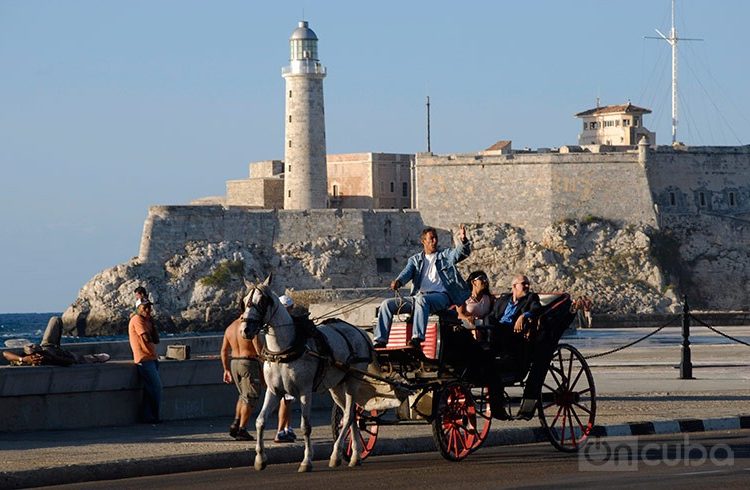The restoration of diplomatic relations between Cuba and the United States marks a historical turning point for both countries. In terms of tourism, various scholars are analyzing the possible impact that could be created by the elimination of U.S. restrictions on travel to Cuba, even though all signs seem to indicate that it won’t happen in the short term. A number of tourism industry analysts have gone ahead and provided their predictions, and Professor José Luis Perelló Cabrera, an economist with the University of Havana’s Center for Tourism Studies, talked to OnCuba about some of these expectations.
We have to take into account that 50.79 percent of tourist arrivals to Cuba come from North America, that is, three large segments: Canada, our top market; the United States; and Cuban-Americans. The process aimed at normalizing relations, in terms of meetings and the signing of agreements, is moving faster than Cuba’s possibilities of preparing for increased tourism. It’s not just a question of U.S. tourism. According to reports from the National Office of Statistics and Information, ONEI, at the close of February 2015, tourism in Cuba (which had already increased compared to the previous year) had grown by 14.2 percent, which means strong growth occurred in all markets except for Russia and Argentina. All of that represents a challenge for Cuba, and time is needed.
It is also known that the United States is the main market for tourists to this part of the world, except for Cuba. It is a market with high levels of spending at the place visited, which represents economic advantages for both countries, translated into more airlines, travel agencies, offers from tour operators, competition in transport, and etc. In addition, there are the so-called gift exchanges. One of the measures announced by the U.S. Office of Foreign Assets Control, OFAC, is that each visitor to Cuba can import up to $400 worth of goods, including up to $100 in cigars and rum. The question would be whether that amount of Cuban-made products is enough to meet demand. In 2014, the island was visited by 91,254 people from the United States for reasons that included religion, education, research, and other, directly bringing in some $146 million for Cuba that year. At the same time, this is a challenge for the country, because it would have to supply its domestic market for foreign consumption.
In that sense, it is necessary to accelerate the pace of new construction provided for under the new Investment Law. This includes the expansion of Terminal 3 at Havana’s José Martí International Airport, which is underway, to achieve a capacity of four million passengers annually. This project could take two years, but during that time, Cuba’s situation could change greatly, increasing demand sharply.
Can we talk about a North American market for Cuba?
I think we should talk about a U.S. market, because in geographical tems, North America includes Canada, which is Cuba’s main tourism market. The reason we need to start doing so is the following: while in Europe we have France, Germany, Italy and Spain, which are all part of a single space or geographic territory, we must then prepare ourselves for considering the U.S. market as one big issuing market—a megamarket—and within that, we would also be talking about California and New York, for which different strategies would have to be prepared.
I can assert that Cuba’s main tourism market is and will continue to be Canada. In 2014, Cuba was visited by 1,175,077 Canadians; however, it is unlikely that will be matched by an equal number of U.S. travelers. Market quotas would have to be analyzed based on historic quotas for the Caribbean; we’re talking about 6.8 million U.S. travelers to this region.
What commercial and tourism interests does Cuba have in this market?
Obviously, the U.S. market is the larger market in terms of both commerce and tourism, and it is closer to Cuba. The interests are mutual. In terms of commerce, Cuba is going to buy a large quantity of products at lower prices, because of proximity, and the United States is going to sell a large quantity of goods to Cuba, increasing its market level. For the United States, the Cuban market is a virgin market that needs—I would say urgently—to be supplied in general to be able to increase the country’s domestic supply, both for foreign visitors and for the domestic market. Logically, the island will return—to a certain extent—to being a place nearby for average U.S. tourists to spend their vacations, consuming the same products that would be sold in the United States, but enjoying Cuba’s idiosyncrasy. I don’t think there are any interests other than commerce, tourism, and goodwill.
In your opinion, what are the most general travel tendencies of U.S. tourism?
I think that the segments that would travel to Cuba, initially, would include people with Latino roots, young people 18-34, and older adults, for short stays. What would be the preferences of these segments that would travel to Cuba? About 78 percent would prefer to visit places of historic/cultural interest; 76 percent would be interested in shopping, including for Cubita coffee, Cuban cigars and cigarettes, a handcrafted guayabera shirt, or maybe a piece of artwork. Visits by these segments to cities and rural areas include so-called people-to-people exchange, authorized by the United States, and regarding which tourism specialists like me say: if only all global tourism were people-to-people, and not just sun and beach. Beyond the cultural and social implications, this type of approach brings the financial advantage of tourism. Tourists who come on all-inclusive trips don’t consume anything in the community; they don’t buy any hats or bats, because they’ve already paid and have everything they need at their hotel.
Forty-one percent would be interested in local food and drink, especially at non-state establishments, and in historic centers and excursions, preferably guided. Cultural and ethnic heritage is another motivation, along with nocturnal activities and aquatic sports, precisely because 18 percent of the interests of tourists to travel to the Caribbean are centered on these types of products. Cuba is an island and should exploit to the maximum its nautical tourism.
In your view, what interest does the U.S. maritime industry have in Cuba? How is the island preparing for nautical tourism?
First of all, we need to take into account that the U.S. maritime industry is the largest in the world. The main cruise companies that operate the largest ships, with 5,400 passengers and 2,400 crew members, are veritable floating resorts. When any of these ships arrive at a destination, it’s comparable to the simultaneous landing at an airport of 16 Boeing 747 jets. Therefore, a whole number of conditions must be prepared for receiving these cruise passengers, who have everything on board and are out to find a people-to-people experience; that is, the attraction is the stopover.
The main ports for these cruise lines are on the southeast coast of Florida, and Cuba is the closest territory for any cruise itinerary. Transport by ferry, such as the commercial maritime lines in southern Florida, uniting the Bahamas and Havana, or direct lines, would permit a daily flow of passengers and cargo, with a significant cost savings for passage and transport.
With respect to yachting, we should note that more than one million recreational yachts sail between the southern coasts of the United States and Cuba. I think that the principal product-sector on the island, the one with the greatest tourism growth, is the nautical one, in every variant. In a scenario of rapprochement in relations with the United States, Cuba could become the principal nautical destination of the greater Caribbean, including its islands and the whole basin.
For this scenario, our country has been preparing a diversity of projects, although the cost of investment is in the millions. It is in that direction that our plan for tourism development and foreign investment should be aimed, as I see it. We are and will be a nautical destination by our very nature, as the largest island in the Antilles and as the center of the American continent’s geography. We are surrounded by water, and from it we will extract resources for building and developing a sustainable country and society.










